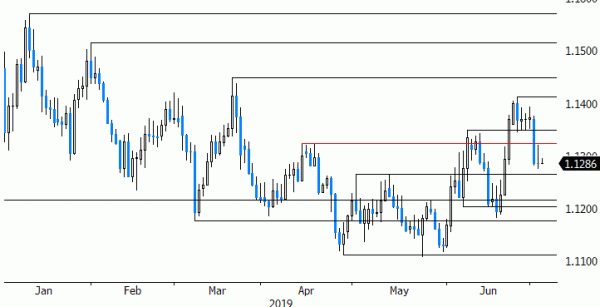- Rates: US 10-yr yield drops to lowest since Nov 2016
German and US (10-yr) yields again declined yesterday with the latter closing below key support at 2% and at the lowest level since November 2016. A sustained break however requires confirmation from the data of which markets get a first glimpse today (ADP, non-manufacturing ISM). Friday’s payrolls might prove crucial. - Currencies: USD softness and euro weakness keep each other in balance, for now
EUR/UISD hovered near 1.13 yesterday. The euro lost slightly ground after the appointment of Christine Lagarde as ECB president. At the same time, the dollar suffered from a further decline in US yields. Today, the focus will be on the US ADP job report and on the non-manufacturing ISM. The report might by neutral for the dollar ahead of Friday’s payrolls
The Sunrise Headlines
- US equities managed a close in green after another choppy session. The S&P (+0.29%) outperformed with another record high. Asian markets are under selling pressure. Japan (-1%) is dealing with a surge in the yen.
- EU leaders nominated current IFM head Lagarde as next ECB chief. German Defense Minister von der Leyen is set to be the next EC president. Belgian prime minister Michel is named as the next European Council president.
- China’s Caixin services PMI declined again in June from 52.7 to 52.0 (52.6 expected) after an already steep drop in May. The composite indicator (50.6) barely manages to stay in expansion territory
- BoE’s Carney said that trade tensions had increased downside risks to the global and UK economy, with the latter also facing a no-deal Brexit threat. He added a “widespread slowdown” may require a policy response. The pound fell.
- The Bank of Japan is pursuing a curve steepening as it cut its bond purchases at the middle (3-5yr, first cut since June 2018) and long (10-25-yr) end of the curve while raising 1-3yr bond buying.
- Trump picked two Fed nominees likely in favour of easier policy. Christopher Waller is research director for St. Louis Fed’s Bullard, who voted for a rate cut in June. Judy Shelton, Trump’s informal advisor, publicly supported lower rates.
- Today’s economic calendar contains US ADP jobs report and the non-manufacturing ISM. The UK releases the services PMI. The Riksbank meets in Sweden. Germany taps the bond market.
Currencies: EUR/USD Returns To The Middle Of The 1.11/1.14 Trading Range
EUR/USD slightly lower on Lagarde appointment
EUR/USD bottomed after Monday’s post G-20 correction yesterday. EUR/USD hovered near 1.13. The pair jumped temporary on rumours that the ECB is in no hurry to already ease policy this month. Later, Christine Lagarde was announced to be next ECB president. She is seen as more tilting to the dovish side compared to other candidates. Still, the euro decline was modest. EUR/USD closed little changed at 1.1285. USD/JPY declined in line with US bond yields and closed at 107.88.
Overnight, Asian equities are facing modest profit taking. The BOJ facilitated some curve steepening as it reduced bond buying in the 3-5 y sector and stepped up buying shorter maturities. It didn’t stop the rise of the yen. USD/JPY dropped to trade in the 107.65 area. EUR/USD is little changed near 1.1285. The China Caixin services PMI dropped to 52.0 (from 52.7) supporting the case of further selective stimulus.
Today, the final EMU services PMI will be published, but the focus is on the US ADP report and the services ISM. ADP job growth is expected to rebound to 140k (from a dismal 27k). The ISM is expected slightly lower at 56.0. Indictors of the manufacturing sector were soft of late, but we’re not sure this should give a big miss for today’s data. Given recent decline in US yields, in line data shouldn’t be that much of an additional USD negative. Still, Investors might take a cautious approach ahead of tomorrow’s 4th of July holiday. Yesterday’s USD/JPY move and, to a lesser extend in the trade-weighted dollar, suggests USD sentiment isn’t that euphoric, but this also applies to the euro. We expect sideways EUR/USD trading going into Friday’s US payrolls.
On Monday, EUR/USD returned to the middle of the 1.11/1.14 range, making the picture neutral. Today’s data, but even more Friday’s payrolls should shape expectations on the Fed rate cut path. First EUR/USD support comes in at 1.1260 ahead of 1.1181 (correction low). A return above 1.1350 would suggest that a new upside test is possible.
EUR/GBP made some intraday swings yesterday, but in the end poor UK data, warnings from Carney on the negative impact of protectionism and a harder stance on Brexit from both contenders in the PM race held sterling near recent lows. Today, the UK Market services PMI is expected little changed at 51. A negative surprise might pull the trigger for a test of the 0.90 barrier
EUR/USD: USD softness and euro weakness for now are keeping each other in balance.













